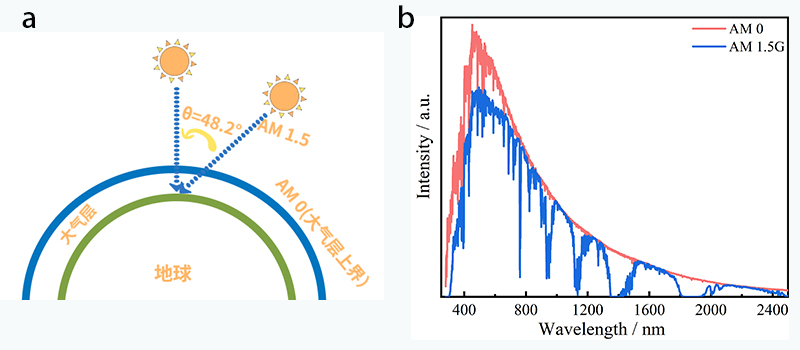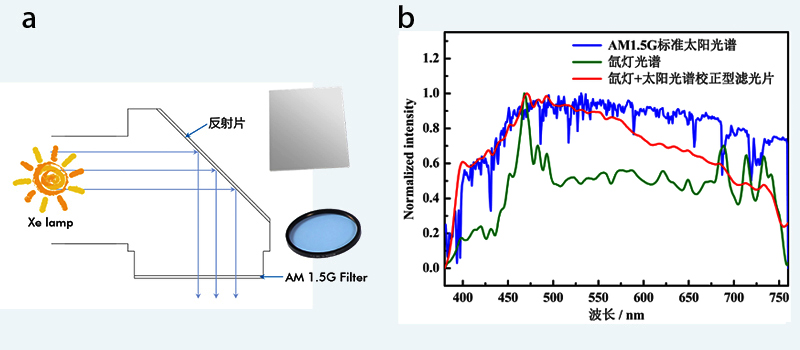Original content is not easy to create. If you wish to republish this article, please contact the staff and include a source attribution in the republished article. Otherwise, copyright infringement measures will be taken!
You've probably come across descriptions like "Xenon lamp source with AM 1.5 G filter" in many literature references. This refers to using a xenon lamp source along with an AM 1.5 G filter. Do you know what AM 1.5 G actually means? How is the AM 1.5 G solar spectrum obtained?

Figure 1. Example of using Microsolar 300 xenon lamp source[1] and PLS-SXE 300D xenon lamp source[2] with AM 1.5G filter.
As sunlight travels through space and the Earth's atmosphere to reach the Earth's surface, its irradiance gradually decreases. In order to quantify the attenuation of solar radiation, people often use "air mass" (AM) as a marker[3].
Let's set the angle between the incident solar rays and the surface normal as θ. The relationship between AM and θ can be expressed as: AM=1/cosθ, as shown in Figure 2.

Figure 2. AM 0, AM 1.5 schematic and AM 0, AM 1.5G solar spectrum.
When θ = 48.2°, it is referred to as AM 1.5. This corresponds to the typical scenario of sunlight irradiating the Earth's surface on a clear day, which is closer to actual human living conditions. The irradiance is 1000 W/m2, or 100 mW/cm2.
AM 1.5G refers to the standard solar spectrum at the Earth's surface. The "G" stands for "Global," and for the purpose of comparing solar conversion efficiency measurements taken at different times and locations, AM 1.5G is defined as the reference solar spectrum for standard testing of solar energy conversion systems[4]. The standard AM 1.5G irradiance is 100 mW/cm2.
In the field of photochemistry research, to obtain the AM 1.5G standard solar spectrum, a xenon lamp source is often used in combination with an AM 1.5G filter as a simulated light source.
Xenon lamp source emits light by discharging high-pressure or ultra-high-pressure xenon gas, producing a continuous spectrum with energy distribution from 200 to 2000 nm. The energy distribution characteristics of a xenon lamp source are very similar to the energy distribution characteristics of solar spectra. However, there are significant deviations in the infrared region between the xenon lamp source and solar spectra. To obtain the AM 1.5G standard solar spectrum, a xenon lamp source needs to be used with a solar spectrum correction filter. This filter consists of an AM 1.5G filter and a total reflector filter.

Figure 3. Xenon lamp source optical path diagram (left), Microsolar 300 xenon lamp source with AM 1.5G filter spectrum and AM 1.5G standard solar spectrum (right).
The reflector, also known as the total reflector, can reflect all the light emitted by the xenon lamp as incident light, with its operating wavelength range from 200 to 1200 nm. Optical characteristics: R > 80% @ 200-300 nm, R > 85% @ 300-650 nm, R > 90% @ 950-1200 nm, R > 75% @ spectral region * low point 800 nm (±25 nm). The AM 1.5G filter combined with the total reflector is used to reflect the AM 1.5G spectrum produced by the xenon lamp source.
The above sections are translations and summaries based on reference materials. If there are errors, please feel free to correct them.
[1] Xi'an Jiaotong University. GB/T 26915-2011 Calculation of Energy Conversion Efficiency and Quantum Efficiency for Solar Photocatalytic Hydrogen Production from Water Splitting System[S]. Beijing: China Standard Press,2012: 18